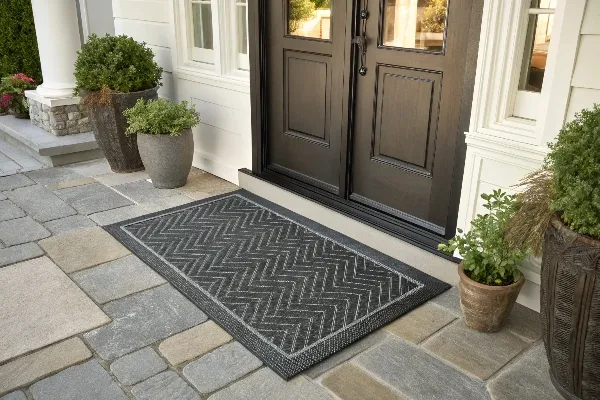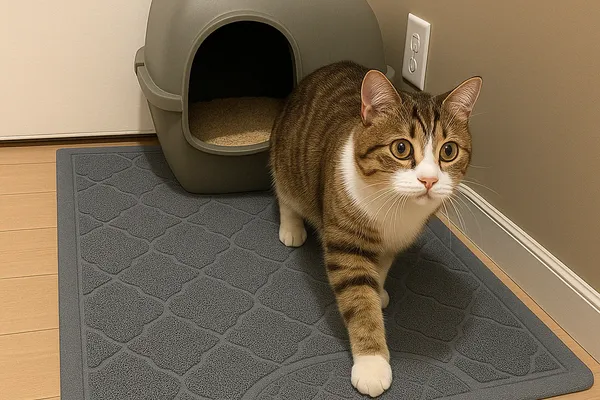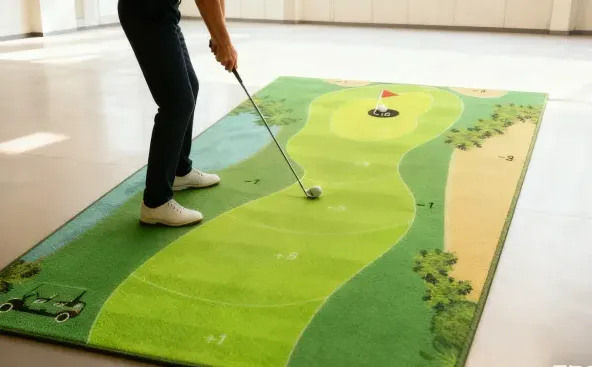Tired of constantly sweeping or mopping tracked-in dirt and debris? Worried about slips and falls on wet floors, or the poor first impression a dirty entryway makes? Finding the right entrance mat solves these problems, keeping your space clean, safe, and welcoming.
A good entrance mat effectively scrapes dirt and absorbs moisture from shoes, features a non-slip backing for safety, and is durable enough to withstand foot traffic and weather conditions. The best doormat choice depends on location (indoor vs. outdoor), traffic volume, climate, and desired aesthetics. Materials like coir, rubber, and synthetics like PVC offer different benefits in trapping dirt and water, ensuring cleanliness and longevity.
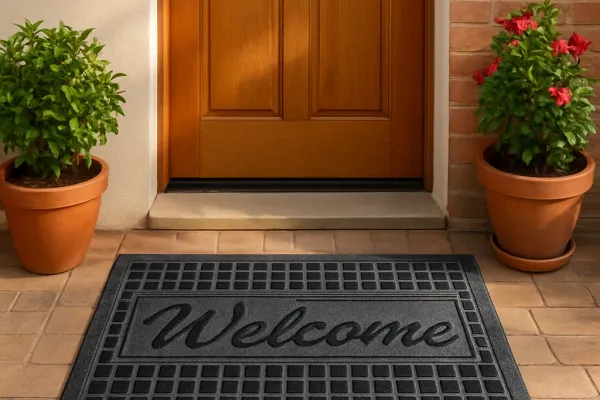
Why is Choosing the Right Entrance Mat So Crucial?
Selecting the right doormat is more than just picking a decorative accessory for your doorstep. It’s a practical decision with significant implications for cleanliness, safety, and the overall presentation of your home or business. An effective entrance mat acts as the first line of defense against the dirt, mud, moisture, and debris that cling to the soles of shoes. Without a proper mat, these unwanted elements get tracked indoors, soiling carpets and floors, increasing cleaning time and costs, and potentially damaging delicate floor coverings.
Think about the first impression your entryway makes. For businesses, a clean, well-maintained entrance speaks volumes about professionalism and attention to detail. A worn-out or ineffective door mat can detract from this image. For homeowners, a welcoming entry mat enhances curb appeal and sets a positive tone for guests. Furthermore, safety is a major concern, especially in commercial spaces or areas prone to wet weather. A good mat with non-slip properties significantly reduces the risk of slips and falls, protecting visitors and mitigating potential liability. Choosing the right mat is an investment in maintaining a clean and safe environment.
As manufacturers specializing in floor solutions, we understand the vital role these mats play. We design our products, from durable commercial anti slip outdoor herringbone front door mats to stylish residential options, focusing on functionality and longevity. The goal is preventing dirt from migrating further into the building, safeguarding your floors and the people who walk on them.
What Key Features Define the Best Mat for Your Entryway?
When trying to find the best mat, several key features distinguish a high-performing product from a merely decorative one. First and foremost is its ability to trap dirt and absorb moisture. The surface texture should be effective at scraping dirt and debris from shoes, while the material needs to be absorbent enough to handle water, snow and ice brought in from outside. Look for mats specifically designed for retaining dirt and moisture.
Durability is another critical factor, especially for a commercial entrance or high-traffic residential entryway. The mat must withstand constant foot traffic without excessive wear and tear. High-quality materials and construction contribute significantly to the lifespan of a doormat. Consider the backing material as well; a sturdy, non-slip rubber backing is essential to keep the mat in place and prevent accidents. If a doormat doesn’t stay put, it becomes a tripping hazard itself.
Finally, consider ease of maintenance. Some mats are machine washable, while others require simple shaking out or hosing down. The best mat for you will balance effectiveness with practicality. Size and shape also matter – the mat should be large enough to allow for a couple of steps to effectively remove dirt and moisture. We offer a range of sizes to suit various doorways, including options for double doors.
How Do Different Mat Materials Perform?
The material of an entrance mat largely determines its effectiveness, durability, and suitability for specific environments. Natural fibers like coir (made from coconut husks) are excellent for scraping dry dirt and debris. Coir mat products are tough, absorbent to a degree, and offer a classic look. However, they can shed fibers and may degrade faster in constantly wet conditions compared to synthetic options. Jute is another natural fiber, often used for indoor mats due to its softer texture but lower water resistance.
Synthetic materials like PVC (polyvinyl chloride), polypropylene, and nylon offer excellent durability and water resistance, making them ideal for both indoor and outdoor use, especially in wet climates. PVC-based mats, showcase the versatility and effectiveness of this material in trapping fine particles and liquids. Polyester is often used for highly absorbent indoor mats that excel at trapping dirt and water. These synthetic floor mats often come in various color options and designs, including intricate patterns or message mats.
Rubber mats, often made from recycled materials, are exceptionally durable and provide excellent scraping action and slip resistance. They are a prime choice for outdoor use or heavy-duty commercial entrance applications. Some mats combine materials, like a synthetic scraping surface with a sturdy rubber backing, offering the best of both worlds. Choosing the right doormat material involves considering weather exposure, traffic levels, and the type of dirt and moisture expected.
| Material | Primary Benefit | Best Use Location | Durability | Water Handling | Example Product Type |
| Coir | Excellent Dirt Scraping | Outdoor (Covered) | Good | Moderate | Classic Coir Mat |
| Rubber | High Durability, Non-Slip | Outdoor/Indoor | Excellent | Excellent (Drainage) | Heavy Duty Outdoor Mat |
| PVC | Water Resistant, Trapping | Outdoor/Indoor | Very Good | Excellent | PVC Coil Mats, Floor Rolls |
| Polypropylene | Scrapes & Absorbs | Outdoor/Indoor | Very Good | Good | Waterhog Style Mats |
| Nylon | High Absorbency, Crush Resistant | Indoor | Excellent | Excellent | Premium Indoor Mats |
| Polyester | Absorbent, Quick Drying | Indoor | Good | Very Good | Absorbent Entry Mat |
| Cotton | Highly Absorbent | Indoor | Moderate | Excellent | Cotton Door Mats |
Should You Choose an Outdoor Mat, an Indoor Mat, or Both?
For the most effective dirt and moisture control strategy, using a combination of an outdoor mat and an indoor mat is highly recommended. Think of it as a two-stage cleaning system for footwear. The outdoor doormat serves as the initial scraper, designed to handle the roughest dirt and debris, mud, snow, and larger particles. These mats need to be weather-resistant and tough, often made from materials like rubber, coir, or durable synthetics. An effective outdoor door mat significantly reduces the amount of grime that even reaches your threshold.
Once inside, the indoor mat takes over. Its primary role is to absorb any remaining moisture and trap finer dirt and dust particles that the outdoor mat might have missed. Indoor mats often feature softer, more absorbent materials like nylon, polyester, or cotton blends. They also tend to offer more aesthetic variety to complement interior decor. Using both types ensures maximum protection for your interior floor coverings and maintains cleanliness and safety.
Consider the journey of someone entering your building: Step 1 occurs on the outdoor doormat, which scrapes off dirt and bulk moisture. Step 2 happens on the indoor mat, which dries soles and catches fine grit. This system is particularly crucial for high-traffic areas or locations experiencing harsh weather. For businesses, this dual-mat approach is essential for maintaining a professional and inviting atmosphere while minimizing cleaning efforts and slip hazards.
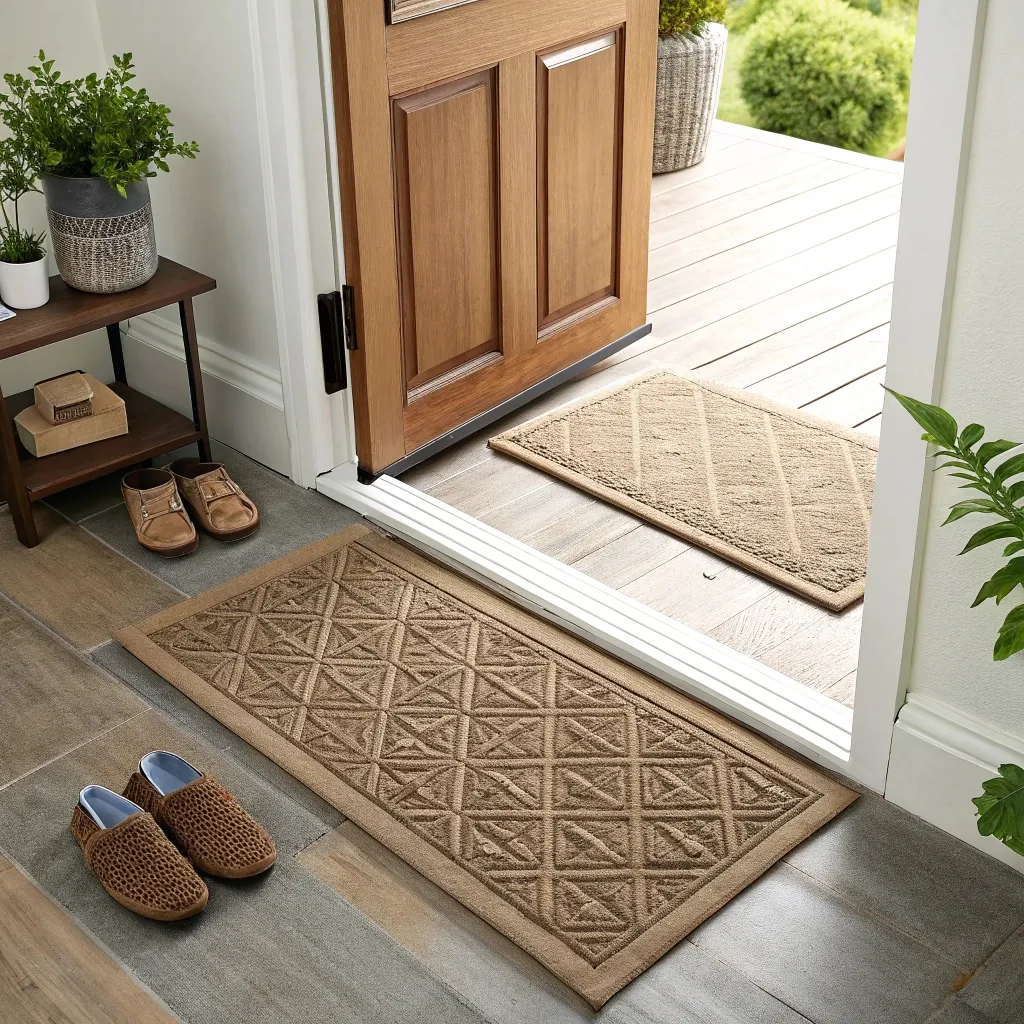
What Makes Waterhog and Guard Doormats Special for High-Traffic Areas?
Certain types of mats are specifically engineered for demanding environments like commercial entrance ways or areas with heavy foot traffic. “Waterhog” style mats (a popular brand name often used generically) and “Guard” doormats fall into this category. What sets them apart is their specialized construction designed for maximum performance in retaining dirt and moisture. The recycled waterhog doormat, for example, often features a bi-level surface pattern. The raised squares or diamonds aggressively scrape dirt and moisture from shoes, while the lower channels trap and hold the water and debris, keeping the walking surface cleaner and drier.
These functional doormats are typically made from highly durable materials like polypropylene or nylon, which resist crushing and maintain their scraping effectiveness over a long lifespan. The backing is almost always heavy-duty rubber, ensuring the mat stays firmly in place, even when wet. A guard doormat often employs similar principles, focusing on aggressive scraping and containment. They are built to handle the relentless wear and tear of busy lobbies, retail stores, schools, and office buildings.
Investing in a Waterhog or Guard style mat means investing in superior floor protection. They excel at preventing dirt, water, and grime from spreading throughout a facility, contributing significantly to lower maintenance costs and enhanced safety by reducing slip hazards. While the initial cost might be higher than a standard mat, their longevity and performance in high foot traffic situations often result in better long-term value, especially for our B2B clients like facility managers and retail chains.
How Important is the Backing of Your Doormat?
The backing of a doormat might seem like a secondary detail, but it’s incredibly important for both safety and functionality. A doormat doesn’t perform well if it slides around every time someone steps on it. The primary role of the backing is to provide non-slip traction, keeping the mat in place on the floor surface. This is crucial for preventing trips and falls, particularly in wet conditions or on smooth flooring like tile or hardwood. A rubber backing is the most common and effective choice for achieving this stability.
Beyond safety, the backing also protects the floor underneath. A good quality backing prevents moisture absorbed by the mat from seeping through and damaging sensitive floor coverings. It also stops rougher mat materials (like coir) from scratching the floor surface. PVC-backed mats also offer excellent non-slip properties and floor protection, often providing a more flexible alternative to solid rubber. When choosing a mat, always check the backing material and ensure it’s suitable for your floor type and conditions.
For commercial spaces, the quality of the backing is non-negotiable due to liability concerns and the need for reliable performance under heavy foot traffic. As manufacturers, we pay close attention to the backing materials we use, ensuring they provide maximum grip and durability. Whether it’s solid rubber on the back or a high-grade PVC, the goal is a stable, secure mat that stays put and does its job effectively without causing harm to the underlying floor.
Can an Entrance Mat Also Be a Design Statement?
Absolutely! While the primary function of an entrance mat is practical – keeping dirt and moisture out – it also plays a significant role in aesthetics and making a first impression. Your entryway is the first thing visitors see, and the doormat can contribute positively to the overall look and feel. Gone are the days when doormats were purely utilitarian and drab. Today, there’s a vast array of designs, colors, and patterns available to complement any architectural style or interior decor.
You can choose the right mat to make a statement, reflect your personality, or reinforce branding. Message mats with welcoming greetings, humorous quotes, or company logos are popular choices. 3D embossed door mats add texture and visual interest. The availability of various color options and patterns in synthetic materials like nylon and polyester allows for greater design flexibility than traditional coir or rubber mats. You can find functional doormats that don’t compromise on style.
As a custom mat manufacturer, we understand the desire for unique and attractive floor mats. We work with clients, including interior designers and promotional product companies, to create custom entrance mats that meet specific design requirements alongside functional needs. Whether it’s a specific color, a unique shape, or incorporating a logo, the modern doormat can be both a hardworking tool and a stylish accent piece for any entryway. Don’t underestimate the power of a well-chosen mat to enhance your space’s appeal.
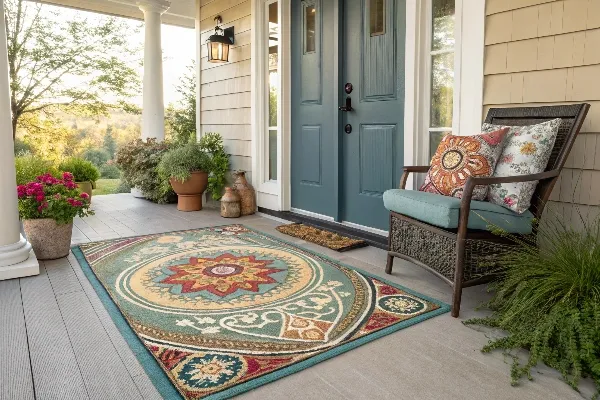
What Size and Shape Doormat Should You Select?
Selecting the appropriate size and shape for your entrance mat is crucial for maximizing its effectiveness. A doormat that is too small won’t provide enough surface area for people to adequately wipe their feet, defeating its purpose. As a general rule, the mat should be wide enough to cover the width of the doorway. Ideally, it should be at least 80% as wide as the door itself. For standard single doors, common sizes like 18″x30″ or 24″x36″ might suffice, but larger is often better.
Consider the length as well. The best doormat allows for at least two full steps to effectively remove dirt and moisture from footwear. For high-traffic areas or commercial entrance locations, a longer runner-style mat might be necessary to ensure sufficient wiping action. If you have double doors or a wider entryway, you’ll need a correspondingly larger mat (e.g., 36″x48″ or even bigger) to provide adequate coverage and maintain visual balance.
Shape can also play a role, although rectangular mats are the most common and practical. Half-moon or oval shapes can add a decorative touch, but ensure they still offer sufficient functional surface area. When working with us, we can produce mats in a range of sizes and even custom shapes to perfectly fit unique entryways. Ultimately, choosing a mat of the right dimensions ensures it not only looks appropriate but, more importantly, performs its job of keeping dirt and wetness contained effectively.
How Can You Ensure the Longevity and Performance of Your Entrance Mat?
Investing in a quality entrance mat is the first step, but proper maintenance is key to ensuring its longevity and continued performance. Regular cleaning prevents the mat from becoming oversaturated with dirt and debris, which can reduce its effectiveness and eventually lead to premature wear and tear. The cleaning method depends largely on the material of the doormat.
For many outdoor mats made of rubber or synthetics, and some coir mats, a simple shake-out or brushing might be sufficient for daily dirt removal. For heavier soiling, hosing them down and allowing them to air dry thoroughly is often recommended. Some synthetic indoor mats, especially those made of polyester or nylon blends, might even be machine washable (always check the manufacturer’s instructions). Regular vacuuming is also effective for most indoor and outdoor doormats to lift loose dirt.
Addressing spills or heavy soiling promptly can prevent staining and maintain the mat’s appearance. Avoid placing coir mats in areas where they will be constantly soaked, as this can accelerate degradation. By following simple maintenance routines, you can significantly extend the lifespan of your mat, ensuring it continues to protect your floors and provide a safe, clean entryway for years to come. Proper care ensures your perfect doormat remains functional.
Looking for Custom or Eco-Friendly Options? Partnering with a Manufacturer.
As importers, distributors, retailers, or brands, trying to find the best mat solutions often means looking beyond standard off-the-shelf products. Partnering directly with a manufacturing plant like ours opens up possibilities for customization, unique designs, and specific material requirements, including eco-friendly options. We understand the diverse needs of the market, from stylish area rug designs adapted for entryways to highly functional commercial entrance solutions.
We pride ourselves on being a reliable source for custom mats. Need message mats with specific branding for a hotel chain? Looking for PVC-backed mats in non-standard sizes for a large retail rollout? Require mats made from recycled materials to meet sustainability goals, like our eco-friendly cat litter mats which demonstrate our commitment to greener options? We have the capability and expertise to deliver. Our experience caters to various sectors, producing everything from pet mats to heavy-duty industrial floor mats.
By working with us, you gain access to a wide range of sizes, materials, and customization capabilities. We can help you choose the right features, materials, and designs to meet your target market’s demands, ensuring quality, functionality, and competitive pricing. We aim to build long-term partnerships by providing reliable production, innovative solutions, and products that enhance cleanliness and safety, whether it’s for homes, commercial spaces, or specialized applications like durable kitchen mats. Contact us to discuss how we can meet your specific floor coverings needs.
Frequently Asked Questions (FAQs)
What type of doormat is best for rain and snow?
For heavy rain and snow, the best doormat options are typically made from durable, water-resistant materials like rubber or synthetics such as polypropylene or PVC. Look for outdoor mats with features like raised borders (to contain water) and textured surfaces or drainage holes to channel moisture away and provide good scraping action for snow and ice. A Waterhog style mat or a heavy-duty rubber mat are excellent choices for handling significant dirt and water.
How often should I replace my entrance mat?
The lifespan of an entrance mat depends on the material quality, the amount of foot traffic it receives, and how well it’s maintained. A high-quality mat in a high-traffic commercial entrance might need replacing every 1-3 years, while a similar mat in a low-traffic home could last much longer. Inspect your mat regularly for signs of wear and tear, such as flattened pile, cracks in the backing, or reduced effectiveness in trapping dirt and moisture. Replace it when it no longer performs its function effectively or becomes a safety hazard.
Are coir mats good for outdoor use?
Coir mats are excellent for scraping dry dirt and debris and are often used as outdoor doormats. However, they are best suited for covered outdoor areas, like porches. While coir is naturally resilient, constant exposure to heavy rain or standing water can cause it to degrade faster, shed excessively, or potentially develop mold or mildew. For fully exposed outdoor locations, rubber or synthetic outdoor mats are generally more durable.
Can I put a doormat on top of carpet?
Yes, you can place a doormat on top of carpet, particularly inside the entryway, to provide an initial barrier against dirt and moisture from shoes. However, ensure the mat has a reliable non-slip backing designed to grip carpet, or use an anti-slip underlay. A standard rubber backing might shift on carpet, potentially creating a tripping hazard. Choose indoor mats designed for carpeted surfaces if possible.
What’s the difference between an entrance mat and a rug?
While both are floor coverings, an entrance mat (or doormat) is specifically designed with the primary function of cleaning shoes and trapping dirt and moisture at entry points. They prioritize durability, scraping ability, absorbency, and non-slip features. A rug, like an area rug, is typically chosen more for aesthetics, comfort, and defining spaces within a room. While some rugs can be placed in entryways, they usually lack the heavy-duty cleaning and moisture-trapping capabilities of a dedicated entrance mat.
How do I choose the perfect doormat for my business?
Choosing the perfect doormat for a business involves considering foot traffic levels, entrance type (commercial entrance specifics), climate, safety regulations, maintenance requirements, and branding. Opt for highly durable materials like rubber or commercial-grade synthetics (nylon, polypropylene). Ensure the mat is large enough for effective cleaning (allowing multiple steps), has a high-traction non-slip backing, and meets any relevant safety standards. Consider message mats or custom logo mats to enhance brand image while ensuring cleanliness and safety.
Key Takeaways for Choosing the Best Entrance Mat:
-
Function First: The primary goal is to trap dirt and absorb moisture effectively. Look for good scraping texture and absorbent materials.
-
Location Matters: Use durable, weather-resistant outdoor mats for the first line of defense and absorbent indoor mats inside. A dual-mat system is ideal.
-
Material Choice: Coir scrapes well (dry dirt), rubber offers durability and slip resistance, and synthetics (PVC, Polypropylene, Nylon) excel in water handling and varied designs.
-
Safety is Paramount: Always choose a mat with a reliable non-slip backing (like rubber backing or PVC) to prevent accidents.
-
Durability for Traffic: Select materials and construction robust enough for your expected foot traffic (residential vs. commercial entrance / high-traffic areas).
-
Size Appropriately: Ensure the mat is wide enough for the doorway (at least 80%) and long enough for 1-2 steps.
-
Maintenance: Consider ease of cleaning (shaking, hosing, vacuuming, machine washable) to ensure longevity.
-
Aesthetics Count: Choose a design, color, or custom mat that complements your space and creates a positive first impression.
-
Partner Wisely: For custom needs, bulk orders, or specialized requirements (eco-friendly, specific sizes), consider partnering with a manufacturer like us for tailored solutions.

